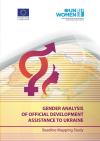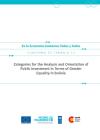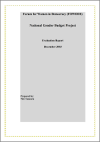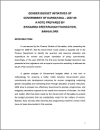FOUND 203 RESULTS
This toolkit follows the transfer of public funds from central to local governments until they reach users such as schools and clinics. It explains how a public expenditure tracking system operates and how it can benefit marginalized groups. With this toolkit local communities can track the inputs, outputs, and outcomes of particular government services, and determine the gender-specific distribution of benefits from those services.
The programme conducts gender analysis of ODA in relation to Ukraine’s national gender equality commitments and analysis of the donor-governmental meetings on gender equality and define a room for participation of gender equality advocates.
Throughout their implementation, the work with GRBs has taken on specific and strategic characteristics in accordance with the proposed goals, the implemented initiatives, the tools used, the political and social context and the institutional and administrative willingness of each country or community. Nevertheless, we can establish the following core goals: To sensitize stakeholders on gender issues and the impact of budgets and policies on them; To make governments accountable for...
This document is a gender analysis of Uganda's 2003-2004 budget prepared by Forum for Women in Democracy (FOWODE) The report discusses some of the emerging gender issues and concerns in the Ugandan 2003-2004 budget, potential gendered outcomes as well as recommendations for achieving future gender-sensitive budgets.
This publication was prepared in 2004 by the Chartered Institute of Public Finance and Accountancy (CIPFA- UK's leading accountancy body for public services) for DFID. Gender and participatory budgeting are increasingly being used in developing countries to give civil society groups or members of a community a means to influence the way public resources are spent. Similar approaches have also been used in the United Kingdom and there is scope for the lessons emerging from developing countries to...
This background paper was prepared for the Commonwealth Secretariat in May 2007 by Mariama Williams, Adjunct Associate, Center of Concern, Washington DC and Research Adviser for the International Gender and Trade Network. The paper explores in great detail to what extent the multilateral trading system can help to support the financing of gender equality and women's economic and social empowerment in Commonwealth developing countries.
The gender assessment conducted in Macedonia attempts to analyze the implementation of the social policy at the local level in three municipalities by identifying to what extent those policies reflect the local needs of men and women, and whether the measures they propose will advance gender equality. The assessment aims to enhance the debate on gender equality issues, and to enable individuals, organizations, policy makers and policy analysts to effectively participate in the development of approaches which would increase the gender responsiveness of social policies.
The booklet produced by NEWW-Polska in 2005, is a report outlining the results of the Gender Budget analysis in Gdansk, Poland. The report provides a detailed discussion of the demographic, education, health and local labor structures in Gdansk. In addition to providing gender budgeting methods and tools used in other countries, the synopsis outlines three selected issues of Gdansk society and presents recommendations which may serve as aids in planning budgets in the region. Central...
Following a commitment by the Finance Minister of Karnataka to create a separate cell in the Finance Department tasked with identifying the quantum and resource allocation and expenditure for women, the first ever Gender Budget document was presented in the year 2007-08 at the Legislature with a hope to improve the sensitivity to address the issues which concerns women.
In India, Gender budgeting as a distinct tool was institutionalized by the introduction of gender budgeting statement in the Union Budget 2005-06. This paper tries to trace the steps taken in this direction by analyzing the pattern of resource allocation under gender budgeting with an in-depth analysis of schemes included in Union Budget 2007-08.







